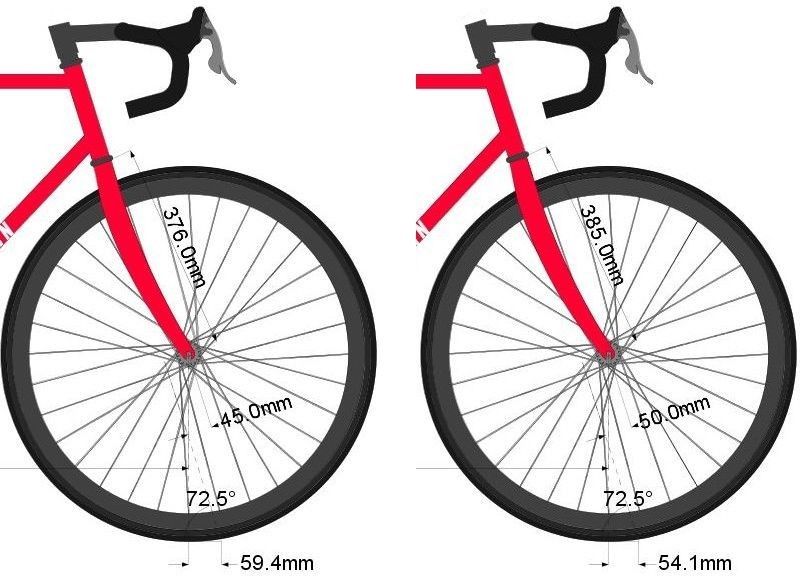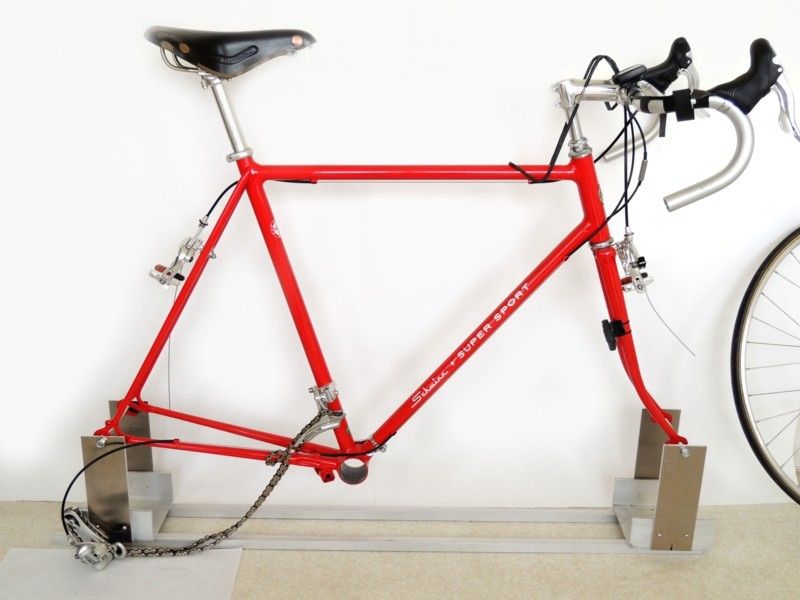Fork rake, head angle and axle-to-crown measurements (Trail)
#1
Senior Member
Thread Starter
Fork rake, head angle and axle-to-crown measurements (Trail)
Was messing around with some online Trail calculators, but I could not find one that allowed me to input axle-to-crown and how it would change trail. So, I need some assistance with fork replacement and if this would keep things close/similar.
1) Stock config: head angle: 72.5mm, fork axle-to-crown: 376mm, rake: 45mm
2) Potential config: head angle (same): 72.5mm, fork axle-to-crown: 385mm, rake: 50mm
Possibly with #2 , the front end would sit up a little higher (which I don't mind), but otherwise am I correct in figuring that because of the increased axle-to-crown the 5mm of rake difference won't be all that noticeable? Basically, I don't want to screw up my handling.
Thanks.
1) Stock config: head angle: 72.5mm, fork axle-to-crown: 376mm, rake: 45mm
2) Potential config: head angle (same): 72.5mm, fork axle-to-crown: 385mm, rake: 50mm
Possibly with #2 , the front end would sit up a little higher (which I don't mind), but otherwise am I correct in figuring that because of the increased axle-to-crown the 5mm of rake difference won't be all that noticeable? Basically, I don't want to screw up my handling.
Thanks.
#2
Senior Member
I stuck a 10mm block under the front wheel of one of my bikes and measured the difference in head angle. It was roughly .5 degrees. That increased the trail by 3mm.
I think you'll be good.
I think you'll be good.
#3
Decrepit Member
Assuming 700c wheels with 25mm tires, the change would reduce your trail by 5.3mm. IMO that would reduce steering stability noticeably.


#4
Senior Member
Thread Starter
If I have a longer fork (with the +50 offset), how would trail increase by more than 5mm (5.3mm by your figures)? Wouldn't it be on the other side of that equation and be more in the 3-4mm range? Maybe I'm thinking about it wrong, but with fork length being longer that should compensate for some of the trail differences, or so I thought.
#5
Lapped 3x
If the fork offset were the same, this would increase trail. Increasing the fork offset REDUCES trail. The offset puts the axle CLOSER to where the steering axis intersects with the ground. The offset is what's decreasing your trail in this instance.
#6
Senior Member
Thread Starter
Maybe I'm understanding this incorrectly:
"Increasing the length of the fork, for example by switching from rigid to suspension, raises the front of a bicycle and thus decreases its head angle. A rule of thumb is a 10 mm change in fork length gives a half degree change in the steering axis angle."
So If my head angle is 72.5 degrees with a 375mm fork, wouldn't it then effectively be 72 degrees with a 385mm fork? Or is that backwards?
"Increasing the length of the fork, for example by switching from rigid to suspension, raises the front of a bicycle and thus decreases its head angle. A rule of thumb is a 10 mm change in fork length gives a half degree change in the steering axis angle."
So If my head angle is 72.5 degrees with a 375mm fork, wouldn't it then effectively be 72 degrees with a 385mm fork? Or is that backwards?
#8
Senior Member
Thread Starter
So if I did some calculations such as the attached picture (assuming for an extra 10mm in length, that would effective reduce head angle by 1/2 a degree), that would be incorrect? Sorry for the questions or lack of understanding...just trying to figure this out best I can given the bits and pieces of correct (and incorrect) information floating around.

This only shows a 2mm difference in trail, which should be acceptable.
This only shows a 2mm difference in trail, which should be acceptable.
#9
Senior Member
Raising the front of the bike slackens (decreases) the head angle. That increases trail. Increasing rake decreases trail. Both numbers are small and nearly cancel each other out.
Even if my numbers are wrong, having built two nearly identical bikes with about 5mm difference in trail, you may notice a difference, it won't be significant enough to make you care.
Even if my numbers are wrong, having built two nearly identical bikes with about 5mm difference in trail, you may notice a difference, it won't be significant enough to make you care.
#10
Decrepit Member
Adding 9mm to the axle-to-crown dimension will change the HTA from 72.5° to 72.3°, which will give you 55.4mm of trail with the 50mm fork rake, so the change from the existing 376mm C-A 45mm rake fork to the 385mm C-A 50mm rake fork will reduce trail by 4mm.
#11
Senior Member
I hope I'm not coming across as argumentative for the sake of arguing. I'm trying to learn as much as I can about what really effects bike handling. I can't trust any sources that originate from the marketing departments at the big bike companies. Most of what they put out to sell their bikes ends up being utter BS.
I'm having to start from scratch here.
#12
Senior Member
Thread Starter
I'm in the same boat. I'm trying to grasp how certain changes affect trail, handling, etc. but there is not an online calculator that takes account for axle-to-crown changes. When I get some time I'll probably do the trig, but in the meantime I see conflicting information most everywhere I go.
But I have seen, in multiple places, that if you add 10mm to the a-to-c, it will result in about 1/2 degree less of head angle.
But I have seen, in multiple places, that if you add 10mm to the a-to-c, it will result in about 1/2 degree less of head angle.
#13
Senior Member
Realize, also, that changing the HTA by .5 degrees also changes the STA by the same amount. So if you maintain the same saddle position relative to the BB, you're sliding the saddle forward (and up, but that's not germaine to the point) by a little over 6mm, which will shorten the reach to the bars. It will also increase the percentage of your weight on the front wheel, which will affect the steering feel.
Everything affects everything else.
Everything affects everything else.
#14
Decrepit Member
I think your calculations concerning the head angle change are off. I just measured 3 different bikes, this time with a 9mm block and I keep coming up with a .5 to .6 degree change. That measurement seems to be supported by some of the other posters although I don't know the source of their information.
I hope I'm not coming across as argumentative for the sake of arguing. I'm trying to learn as much as I can about what really effects bike handling. I can't trust any sources that originate from the marketing departments at the big bike companies. Most of what they put out to sell their bikes ends up being utter BS.
I'm having to start from scratch here.
I hope I'm not coming across as argumentative for the sake of arguing. I'm trying to learn as much as I can about what really effects bike handling. I can't trust any sources that originate from the marketing departments at the big bike companies. Most of what they put out to sell their bikes ends up being utter BS.
I'm having to start from scratch here.
But I could be wrong. I'm not trying to be argumentative either.

The front and rear brackets sit on two extruded aluminum box beams which are used as a level reference by zeroing the WR300. I measured the HTA without the 9mm paperback to get the HTA using the stock fork, then inserted the paperback between the box beams and the bottom of the bracket and measured the HTA again. With the paperback, the HTA was 0.2° slacker than with the front bracket sitting directly on the box beams.

#15
Senior Member
I arrived at the 0.2° difference by measuring the HTA without and then with a 9mm thick paperback book under the fork dropouts with a Wixey WR300 digital angle gauge on the head tube. I have a jig that I use for measuring frame geometry that gives me accurate, repeatable numbers.
But I could be wrong. I'm not trying to be argumentative either.
The front and rear brackets sit on two extruded aluminum box beams which are used as a level reference by zeroing the WR300. I measured the HTA without the 9mm paperback to get the HTA using the stock fork, then inserted the paperback between the box beams and the bottom of the bracket and measured the HTA again. With the paperback, the HTA was 0.2° slacker than with the front bracket sitting directly on the box beams.

But I could be wrong. I'm not trying to be argumentative either.

The front and rear brackets sit on two extruded aluminum box beams which are used as a level reference by zeroing the WR300. I measured the HTA without the 9mm paperback to get the HTA using the stock fork, then inserted the paperback between the box beams and the bottom of the bracket and measured the HTA again. With the paperback, the HTA was 0.2° slacker than with the front bracket sitting directly on the box beams.

#16
Decrepit Member
The pivot point on your setup is the rear axle. I think the actual pivot point would be the rear tire contact patch. I've had a couple glasses of wine. I can't really figure out if that's correct or what the effect would be between your setup and mine with a block under the front wheel.
#17
Lapped 3x
The pivot point on your setup is the rear axle. I think the actual pivot point would be the rear tire contact patch. I've had a couple glasses of wine. I can't really figure out if that's correct or what the effect would be between your setup and mine with a block under the front wheel.
#18
Lapped 3x
So we've figured out that the change in HTA is inversely proportional to the size of the frame/wheelbase. We've also learned that the trail is inversely proportional to increase in offset. Offset has a more direct/greater influence on trail than a change in HTA. So axle to crown changes won't affect the steering much, if at all, as long as the same fork offset is kept, but changing to a larger offset will have a large effect on steering geometry, even if the change in offset is minimal.
#19
Senior Member
Thread Starter
Sheldon Brown's page:
Fork Lengths by Damon Rinard
He also uses the rear axle as the pivot point when changing a-to-c. His numbers tend to agree that with a ~10mm longer a-to-c, the head angle will decrease by about .5 degrees. So that 45mm to 50mm fork won't quite be as drastic as a 5mm change in trail. It *should* be a bit less. I just don't know what that number is exactly.
Anyhow, I appreciate the conversation on this. It's helped me have a bit more understanding about what's going on with front-end geometry.
Fork Lengths by Damon Rinard
He also uses the rear axle as the pivot point when changing a-to-c. His numbers tend to agree that with a ~10mm longer a-to-c, the head angle will decrease by about .5 degrees. So that 45mm to 50mm fork won't quite be as drastic as a 5mm change in trail. It *should* be a bit less. I just don't know what that number is exactly.
Anyhow, I appreciate the conversation on this. It's helped me have a bit more understanding about what's going on with front-end geometry.







